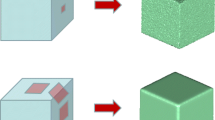Abstract
During recent years, CR-39 detector measurements have gained attention due to improvements in image processing methods. An assessment method based on the application of a high-resolution slide scanner and its quality checks is introduced, using commercially available software and hardware. Using the conventional (visual) comparing analysis for 563 detectors, the method was found suitable for high-precision and reliable track analysis. The accuracy of the measurements were not disturbed by any other pseudo-tracks (scratches or contamination) due to the signal shape of the analysis.







Similar content being viewed by others
References
Young DA (1958) Nature 182:375–377
Silk ECH, Barnes RS (1959) Examination of fission fragment tracks with an electron microscope. Phil Mag 4:970–971
Gold R, Armani RJ, Roberts JH (1968) Absolute fission-rate measurements with solid-state track recorders. Nucl Sci Eng 34:13–32
Szeiler G, Somlai J, Ishikawa T, Omori Y, Mishra R, Sapra BK, Mayya YS, Tokonami S, Csordás A, Kovács T (2012) Preliminary results from an indoor radon thoron survey in Hungary. Radiat Prot Dosimetry 152:243–246
Adams JH Jr (1980) Automated track measurements in CR-39. Nucl Tracks 4:67–76
Gold R, Roberts JH, Preston CC, McNeece JP, Ruddy FH (1984) The status of automated nuclear scanning systems. Nucl Tracks Radiat Meas 8:187–197
Dolleiser M, Hashemi-Nezhad SR (2002) A fully automated optical microscope for the analysis of particle tracks in solids. Nucl Instrum Methods Phys Res B 198:98–107
Yasuda N, Namiki K, Honma Y, Umeshima Y, Marumo Y, Ishii H, Benton ER (2005) Development of a high speed imaging microscope and new software for nuclear track detector analysis. Radiat Meas 40:311–315
Moore ME (2002) Laser illuminated etched track scattering (LITES) dosimetry system. Radiat Prot Dosimetry 101:43–45
Bedogni R (2003) Development of a reader for the routine analysis of CR-39 fast neutron dosimeter’s improvement of the dosimetric performance using automatic vision and motion tools. Radiat Meas 36:239–243
Hulber E (2009) Overview of PADC nuclear track readers. Recent trends and solutions. Radia Meas 44:821–825
Vaginay F, Fromm M, Pusset D, Meesen G, Chambaudet A, Poffijn A (2001) 3-D Confocal microscopy track analysis—a promising tool for determining CR-39 response function. Radiat Meas 34:123–127
Félix-Bautista R, Hernández-Hernández C, Zendejas-Leal BE, Fragoso R, Golzarri JI, Vázquez-López C, Espinosa G (2013) Evolution of etched nuclear track profiles of alpha particles in CR-39 by atomic force microscopy. Radiat Meas 50:197–200
Steele JD, Bhakta JR, Tanner RJ, Bartlett DT (1999) Development of a reader for track etch detectors based on a commercially available slide scanner. Radiat Meas 31:179–184
Ibrahimi ZF, Miles JCH (2008) Performance review of a slide scanner-based automated counting system for PADC radon detectors. Radiat Meas 43:S395–S400
Tsankov L, Pressyanov D, Mitev K, Georgiev S, Dimitrova I (2005) Automatic counting of chemically etched tracks by means of a computer scanner. Radiat Meas 39:557–559
Fairchild R, Tjong L, Wright T (2011) Automatic radon solid state track detector measurements. Radiat Meas 46:1773–1777
Fews AP (1992) Fully automated image analysis of etched tracks in CR-39. Nucl Instrum Methods Phys Res B 71:465–478
Pálfalvi J, Sajó-Bohus L, Eördögh I (1999) First international intercomparison of image analysers. Radiat Meas 31:157–166
Somogyi G, Szalay AS (1973) Nucl Instrum Methods 109:211
Fews AP, Henshaw DL (1982) Nucl Instrum Methods 197:517
Fromm M, Meyer P, Chambaudet A (1996) Nucl Instrum Methods Phys Res 107:337
Nikezic D, Yu KN (2003) Radiat Meas 37:39
Pálfalvi JK, Eördögh I, Szász K, Sajó-Bohus L (1996) A new generation image analyser for evaluating SSNTDs. Radiat Meas 28:849–852
Acknowledgments
This work was supported by the Hungarian Research Grant OTKA No. K 81975 and Hungarian State and the European Union projects Grant No. TÁMOP-4.2.2.A-11/1/KONV-2012-0071.
Author information
Authors and Affiliations
Corresponding author
Rights and permissions
About this article
Cite this article
Bátor, G., Csordás, A., Horváth, D. et al. A comparison of a track shape analysis-based automated slide scanner system with traditional methods. J Radioanal Nucl Chem 306, 333–339 (2015). https://doi.org/10.1007/s10967-015-4013-9
Received:
Published:
Issue Date:
DOI: https://doi.org/10.1007/s10967-015-4013-9




